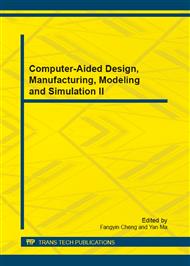p.782
p.786
p.790
p.797
p.801
p.806
p.811
p.817
p.822
Control Performance Analysis of SR S/G System Based on FEM
Abstract:
Switched reluctance machine (SRM) has many outstanding advantages, and can be widely used in many electromechanical applications. However, it’s relatively difficult to analyze the control performance of SRM due to strong nonlinearity of the electromagnetic field. In this paper, the performance of SRM is analyzed by finite element method (FEM). Firstly, the simulation model of a 4-phase 8/6 pole SRM is built, and then the steady-state and dynamic simulation are carried out. In steady-state simulation, the magnetization and torque characteristics are obtained by parametric method. In dynamic simulation, the performance, include current and torque curve, under both motoring and generating mode are given. The simulation and analysis results are useful for performance optimization of SRM.
Info:
Periodical:
Pages:
801-805
Citation:
Online since:
December 2012
Authors:
Price:
Сopyright:
© 2013 Trans Tech Publications Ltd. All Rights Reserved
Share:
Citation:


